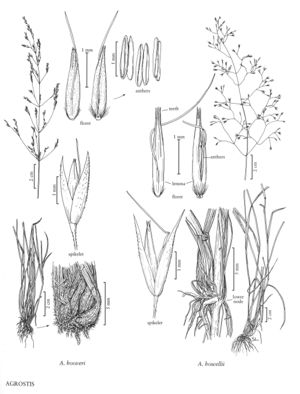Difference between revisions of "Agrostis howellii"
imported>Volume Importer |
GeoffLevin (talk | contribs) m (Restored period to Scribn. in authority) |
||
| Line 1: | Line 1: | ||
{{Treatment/ID | {{Treatment/ID | ||
|accepted_name=Agrostis howellii | |accepted_name=Agrostis howellii | ||
| − | |accepted_authority=Scribn | + | |accepted_authority=Scribn. |
|publications= | |publications= | ||
|common_names=Howell's bent | |common_names=Howell's bent | ||
| Line 30: | Line 30: | ||
-->{{#Taxon: | -->{{#Taxon: | ||
name=Agrostis howellii | name=Agrostis howellii | ||
| − | |authority=Scribn | + | |authority=Scribn. |
|rank=species | |rank=species | ||
|parent rank=genus | |parent rank=genus | ||
Latest revision as of 14:37, 9 December 2021
Plants perennial; cespitose, not rhizomatous, not stoloniferous. Culms 40-80 cm, geniculate and decumbent at the base, sometimes rooting at the lower nodes, with 3-6 nodes. Leaves mostly cauline; basal leaves withered by anthesis; cauline leaves persisting; sheaths smooth or scabridulous; ligules (0.9)2.7-5 mm, dorsal surfaces scabrous, apices truncate to acute, erose to lacerate; blades 15-20 cm long, 3-5 mm wide, flat. Panicles 10-25 cm long, 3.5-11 cm wide, ovate, open and diffuse, bases usually exserted, rarely enclosed in the upper sheaths, lowest node with (1)2-6 branches; branches scabridulous, flexuous, spreading, spikelets usually only on the distal 1/2, lower branches 3-10 cm; pedicels 1.2-9.4 mm. Spikelets ovate to lanceolate, green, not or slightly tinged with purple. Glumes unequal, 2.3-3.5 mm, 1(3)-veined, veins scabridulous, acute to acuminate; callus hairs to 0.3 mm, abundant; lemmas 2.5-3 mm, usually smooth, sometimes scabridulous, translucent to opaque, 5-veined, veins prominent distally or obscure, apices acute to obtuse, lateral veins extending as 4 teeth to 0.5 mm, awned from the lower 1/3, awns 4-6 mm, geniculate; paleas absent or minute; anthers 3, 1-1.3 mm. Caryopses 1.2-1.6 mm; endosperm liquid. 2n = 28.
Discussion
Agrostis howellii is a rare Washington and Oregon endemic, growing in shady woodlands and at the base of cliffs.
Selected References
None.
